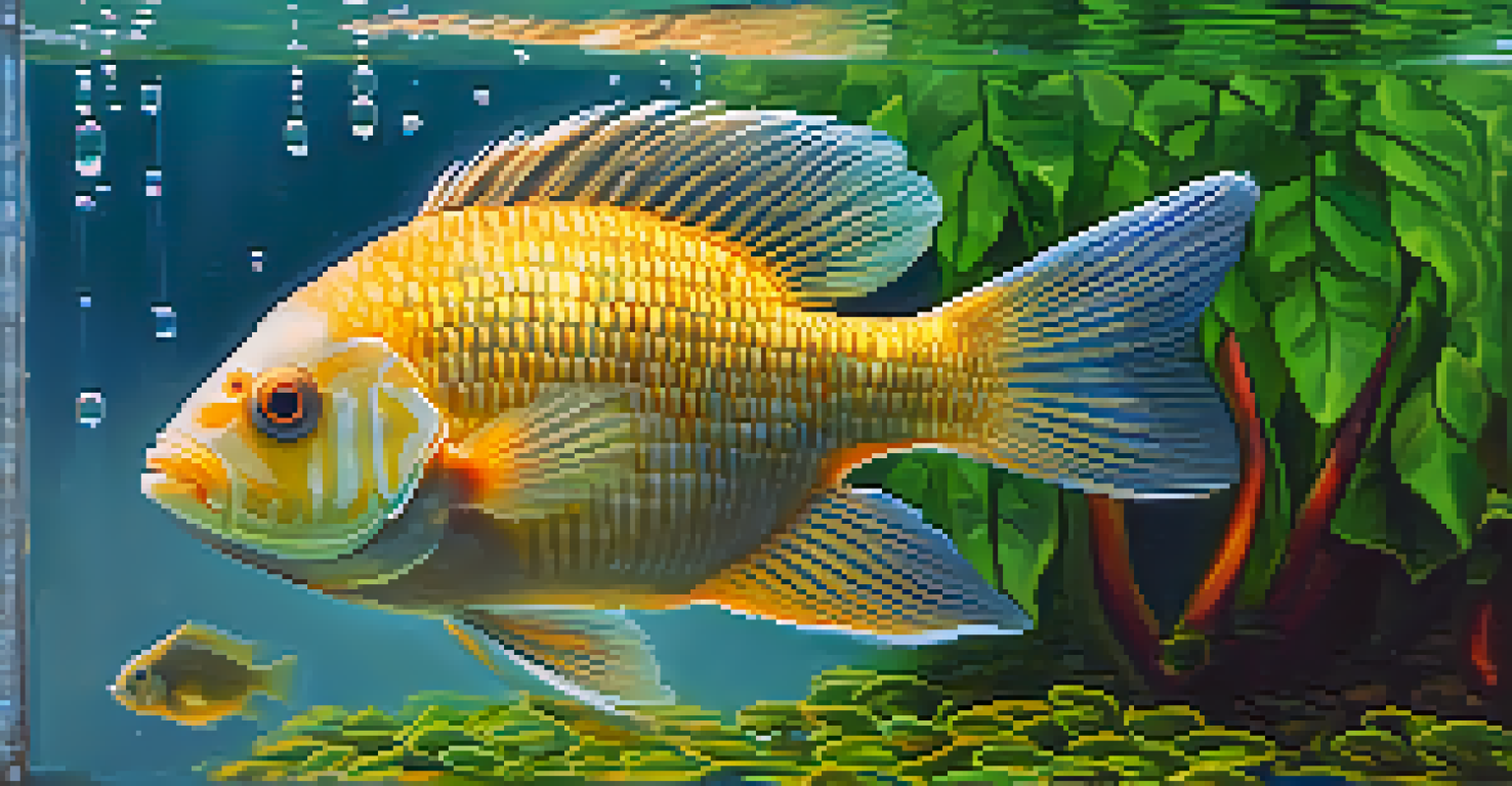The Role of Fish in Aquaponics: Nutrient Production Explained

What is Aquaponics and Its Importance
Aquaponics is a sustainable farming method that combines aquaculture, or fish farming, with hydroponics, the cultivation of plants in water. This innovative system creates a symbiotic environment, where fish waste provides an organic nutrient source for plants, while plants help filter and purify the water for the fish. The importance of aquaponics lies in its ability to produce food in a resource-efficient manner, reducing the need for chemical fertilizers and extensive land use.
Sustainable agriculture is a necessity, not a choice, for the future of our planet.
In a world increasingly focused on sustainability, aquaponics presents a viable solution to food security challenges. It allows for year-round production, even in urban settings, where space is limited. By integrating fish and plants, aquaponics fosters a self-sustaining ecosystem, promoting biodiversity and reducing environmental impact.
Moreover, aquaponics systems can be tailored to various scales, from backyard gardens to commercial operations. This versatility makes aquaponics not just a trend but a practical approach for future food production, aligning with global efforts to cultivate more sustainable agricultural practices.
The Role of Fish in Nutrient Production
Fish play a crucial role in aquaponics by producing waste that serves as a nutrient source for plants. When fish excrete waste, it primarily consists of ammonia, which can be toxic to them in high concentrations. However, this ammonia is a goldmine for plants, as it is converted into nitrates through beneficial bacteria in the system, providing essential nutrients that promote healthy plant growth.

The relationship between fish and plants in aquaponics demonstrates a fascinating cycle of nutrient exchange. As fish waste breaks down, it enriches the water, making it nutrient-dense. In return, the plants absorb these nutrients and, through photosynthesis, help to purify the water, creating a balanced ecosystem.
Aquaponics: A Sustainable Farming Method
Aquaponics combines fish farming and plant cultivation in a symbiotic system, promoting resource efficiency and reducing chemical use.
By selecting the right species of fish, aquaponics practitioners can optimize nutrient production. For instance, tilapia is popular due to its hardiness and efficient waste production, which supports a wide variety of plants. This symbiotic relationship is fundamental to the success of aquaponics systems, showcasing how fish are not just inhabitants but essential contributors.
Choosing the Right Fish for Aquaponics
Selecting the appropriate fish species is vital for the success of an aquaponics system. Factors such as water temperature, pH levels, and the types of plants being grown all influence this decision. Common fish choices include tilapia, catfish, and goldfish, each with unique care requirements and benefits.
In every walk with nature, one receives far more than he seeks.
For instance, tilapia thrives in warmer water and can tolerate a range of conditions, making it a favorite among aquaponics enthusiasts. Catfish, on the other hand, are resilient and grow quickly, providing a steady source of nutrients. Understanding these characteristics helps ensure that the fish not only survive but thrive, promoting a healthy ecosystem.
Additionally, it's essential to consider the fish's growth rate and waste production levels. A fish that grows quickly and produces ample waste will support a more productive aquaponics system, benefiting the plants significantly. Thus, choosing the right fish is a blend of science and strategy for successful aquaponics.
The Nitrogen Cycle in Aquaponics
The nitrogen cycle is a fundamental concept in aquaponics, as it governs how fish waste is transformed into nutrients for plants. It begins with fish excreting waste, which is rich in ammonia. This ammonia is then converted into nitrites by beneficial bacteria, and subsequently into nitrates, which are the form of nitrogen that plants can readily absorb.
This natural process illustrates the importance of maintaining a balanced ecosystem within the aquaponics system. If the nitrogen cycle is disrupted, it can lead to unhealthy water conditions for fish and inadequate nutrient availability for plants. Therefore, monitoring water quality and maintaining appropriate levels of bacteria are essential for the health of the entire system.
The Nitrogen Cycle is Essential
The nitrogen cycle transforms fish waste into nutrients for plants, highlighting the interconnectedness of aquatic and plant life in aquaponics.
In essence, the nitrogen cycle acts as the lifeblood of aquaponics, ensuring that nutrients flow efficiently from fish to plants. Understanding this cycle is key for aquaponics practitioners, as it highlights the interconnectedness of all organisms within the system and the importance of maintaining a healthy environment.
Benefits of Using Fish in Aquaponics Systems
Incorporating fish into aquaponics systems offers numerous benefits that go beyond just nutrient production. Firstly, fish provide a sustainable source of protein, making aquaponics an attractive option for food security. This dual production of fish and plants allows for a more diversified diet and increased food resilience.
Moreover, fish contribute to the overall efficiency of the system. Their waste acts as a natural fertilizer, reducing the need for chemical inputs and promoting organic farming practices. This not only benefits the environment but also appeals to health-conscious consumers looking for organic produce.
Additionally, fish can enhance the overall biodiversity of the aquaponics system. By introducing various fish species, practitioners can mimic natural ecosystems, leading to improved system stability and resilience against pests and diseases. Thus, the integration of fish enriches the aquaponics experience, creating a more holistic approach to food production.
Common Challenges in Managing Fish in Aquaponics
While fish are essential to aquaponics, managing them comes with its own set of challenges. One common issue is maintaining water quality, as fish are sensitive to changes in their environment. Factors such as ammonia levels, pH, and temperature all need to be closely monitored to ensure fish health and optimal nutrient production.
Another challenge is disease management. Fish can be prone to various diseases that can spread rapidly in the confined spaces of an aquaponics system. Preventive measures such as regular health checks, maintaining clean water, and ensuring proper feeding practices can help mitigate these risks and keep fish populations healthy.
Choosing Fish Enhances Ecosystem Health
Selecting the right fish species is crucial for optimizing nutrient production and maintaining a balanced aquaponics system.
Lastly, the balance between fish and plant populations can be tricky to manage. Overcrowding fish can lead to excessive waste and poor water quality, while too few fish may not produce enough nutrients for the plants. Finding the right balance is crucial for a thriving aquaponics system, requiring careful planning and ongoing adjustments.
Conclusion: The Future of Fish in Aquaponics
In conclusion, fish play a pivotal role in the success of aquaponics systems by providing essential nutrients for plant growth. As interest in sustainable farming practices continues to rise, understanding the relationship between fish and plants becomes increasingly important. This knowledge not only helps optimize aquaponics systems but also promotes a more sustainable approach to food production.
Moreover, the versatility of aquaponics allows for experimentation with different fish and plant combinations, paving the way for innovation in the field. As technology advances, we may see even more efficient systems that leverage the natural synergy between fish and plants, enhancing productivity and sustainability.

Ultimately, the future of aquaponics looks promising, with fish at its core, creating a harmonious balance that benefits both agricultural practices and the environment. By embracing this symbiotic relationship, we can work towards a more sustainable and resilient food system.